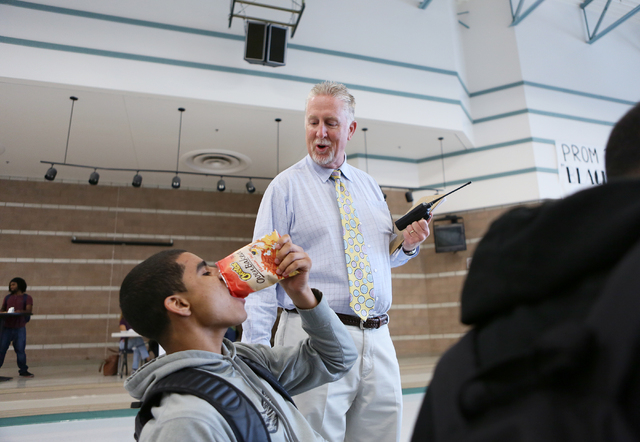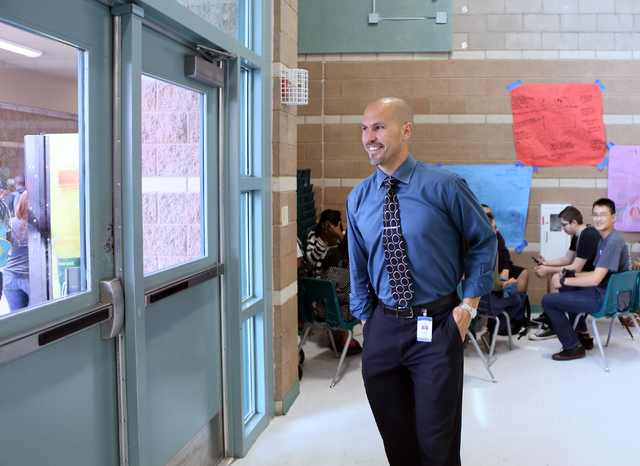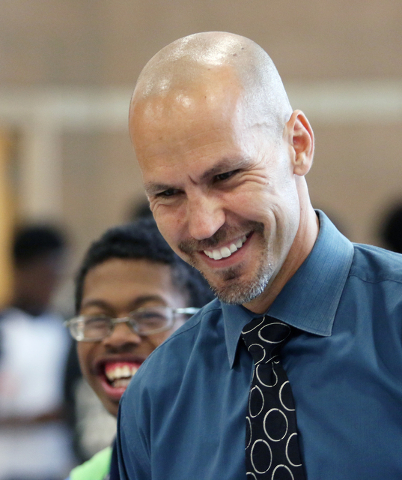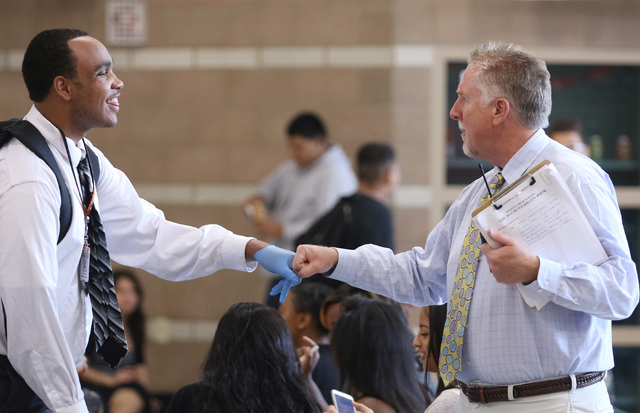Turnaround schools tipping the scales in students’ favor







Reputations can be hard to mend, and the reputations that follow at-risk schools are hard to leave behind, which is what prompted the creation of a program that helps schools turn around.
Nonetheless, Mojave High School, Canyon Springs High School, Wilhelm Elementary School and recently added Fitzgerald Elementary School have taken up the challenge.
“Gallup did a survey a while ago and found that the single greatest factor as to why kids drop out is the lack of hope,” Mojave High School principal Antonio Rael said. “When they lose hope in the potential to graduate, that’s when they shut down and give up. We’ve turned our focuses on giving kids hope, finding things that kids love to draw them into the school.”
WHAT IS A TURNAROUND SCHOOL?
The website ccsdturnaroundzone.net says Turnaround Schools are those that have chronically underperformed and are in need of a renewed focus that emphasizes helping students achieve and grow.
Under the Turnaround Schools model, underperforming schools receive additional resources, including extra funds to either extend instruction time or extend the contractual day to increase staff training and collaboration.
Principals at Turnaround Schools have the opportunity to select their administrative team and have budget flexibility to strategically staff their school.
Schools are selected for support and supervision by the Turnaround Zone based on academic performance.
These schools remain under supervision of the Turnaround Zone for four years to ensure the proper structures, functions and processes are being implemented to create long-term sustainability.
THE NEED FOR CHANGE
Mojave High School, 5302 Goldfield St., was one of the Clark County School District’s most troubled schools.
Before Rael took over for the 2011-12 school year, Mojave had 17 long-term substitute teachers, graffiti covering the walls and an almost 40 percent graduation rate.
“We know the community has extenuating pressures, whether those be gang activity or crime,” Rael said. “That’s not to say that that’s the whole totality of our community, but there are certainly pockets of that that are influences on our kids.”
Seventy-five percent of the students enrolled at the school are enrolled in free or reduced breakfast and lunch programs, and 90 percent of the population identify as a minority.
“During the former principal’s time, the economy went bad, and that really affected the surrounding neighborhood,” said Clorinda Fontano, mother of a junior student. “Legacy High School opened around 2006, and as a casual observer, I noticed that all the good kids went to Legacy. That took a lot away from Mojave.”
Similarly, Canyon Springs High School, 350 E. Alexander Road, was known as one of the district’s most violent schools.
Two years ago, three students were attacked at gunpoint in the facility’s parking lot.
“Before I took over the 2012-13 school year, there were about 18 students being expelled and 19 police incidents per month,” principal Ronnie Guerzon said. “Many students entered the school with a sixth- or third-grade reading level, and 68 percent of the student population qualified for free or reduced meals.”
Before entering the turnaround program, the graduation rate was 48 percent at the predominantly minority-attended school.
Unlike the high schools, the elementary schools faced a different challenge.
Wilhelm Elementary School principal Debra Jones entered the school at 609 W. Alexander Road in the 2013-14 school year.
“One of the big issues was the students’ behavior,” Jones said. “Kids pretty much did what they wanted. There was no accountability. Students were in and out of the classrooms all of the time, and there were no consequences.”
She added that parents were also not involved in the school because they did not feel welcome, and there was a high transient student rate.
Fitzgerald Elementary School, 2651 Revere St., was added to the turnaround program this year.
Principal Fred Watson entered the school in April and hopes to turn the one-star school into a five-star one through additional activities and programs.
“We want to teach students career skills to prepare them early on for jobs,” Watson said. “It is my goal to provide students with things that their parents may not be able to pay for. We want to fill in the gaps that are missing with effective teachers, programs and lessons.”
THE TRANSFORMATION
Rael used the turnaround model to create drastic changes.
As part of the transformation process, Rael replaced 75 percent of the staff at Mojave and renovated the campus.
“I went around and observed every teacher in the classroom, reviewed all of their personnel files and then interviewed each one of them,” Rael said.
In June 2011, the teachers went through a specialized training program called Capturing Kid’s Hearts, which focuses on developing powerful relationships with students.
“During my freshman year, there was a bad atmosphere at the school,” former student Candace Harris said. “The teachers didn’t care because they knew they were being replaced, the school was dirty, and we rarely saw the principal. We didn’t learn much.”
“One of the things we were keenly aware of early on was the reputation that Mojave had in our community,” Rael said. “That’s something we’re still trying to separate — the old Mojave versus the new Mojave. Some students were really ashamed about the reputation that Mojave had, and it wasn’t fully deserved. There are a lot of great students on our campus, but getting past that reputation was and is a big hurdle.”
Efforts involved removing graffiti and adding specialty programs, including an agriculture program, an engineering partnership with Made in America, the Army Junior Reserve Officer Training Corps and a sports medicine program.
With approximately 2,200 students enrolled at the school, the challenges Rael faces are still plenty, but he said he’s happy with the progress.
The high school’s academic success is seen through its 20 percent graduation rate increase and growth in reading and science.
“We know that the kids that start with us and stay with us end up being successful,” Rael said. “For those students last year that stayed at Mojave for four consecutive years, the graduation rate was 80 percent. In addition, the school has won one state championships in track, two state championships in men’s volleyball and four state championships in guitar.
“We wanted to institute a different discipline philosophy with really firm boundaries and expectations, but those firm boundaries rooted in love,” Rael said. “We’re disciplining them not because we don’t love our students but because we do love them.”
Canyon Springs High School took a different approach and kept 95 percent of its teaching staff.
“The first thing I wanted to tackle was getting to know the students,” Guerzon said. “I realized that what was missing in the past was the ability to give students exactly what they need at the precise moment they needed it. We had excellent teachers; we just needed a different approach.”
Guerzon wanted to add more learning time, so he changed the bell schedule to add one extra period per day and extended the lunch period.
He had teachers meet with one another to collaborate daily and hired three instructional coaches in English, math, special education and English language learners to work with the teachers.
“Our main goal now has been to inspire our students from the beginning, so they can start strong and stay strong, like our motto states,” said Treemonisha Miller, freshman academy department chairwoman and algebra 1 teacher leader.
“Teachers don’t just teach from the textbook; they teach students life lessons,” senior Jack Wier said.
As a result, the graduation rate has increased by 17 percent in two years.
Guerzon added that the school received the 2015 GRAMMY Signature Schools Enterprise Award; its We the People competition team qualified for the national finals; and recently, its baseball team made the playoffs for the first time in the school’s history.
Police incidents and expulsions have also gone down to roughly five per month.
Despite losing the grant money in the upcoming school year, Guerzon is hopeful the school will remain successful.
At Wilhelm Elementary School, Jones designed a schoolwide discipline plan.
“We connected with parents and explained the importance of having a student at school,” Jones said. “If students are not in the classroom, then there is no learning going on.”
Jones also hired 21 new teachers and developed a reading program.
“The academic results were so low at this school that we needed to make drastic changes right away; kids needed to learn,” Jones said. “Reading affects every subject — math, writing, everything. So we added a new reading structure with independent reading time.”
Although Watson only recently took over at Fitzgerald, he has big plans for the upcoming academic year.
In addition to creating a STEM lab and a computer coding and robotics program, he hopes to expose students to Mandarin Chinese, nutrition classes and violin and piano programs.
“We can’t control what happens with these students at home or the environment that they live in,” Watson said. “But these students deserve to be successful regardless of their circumstances.”
For more information about the turnaround program, visit ccsdturnaroundzone.net.
To reach North View reporter Sandy Lopez, email slopez@viewnews.com or call 702-383-4686. Find her on Twitter: @JournalismSandy.












